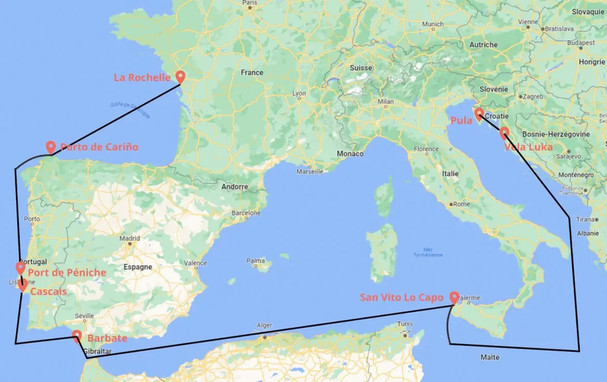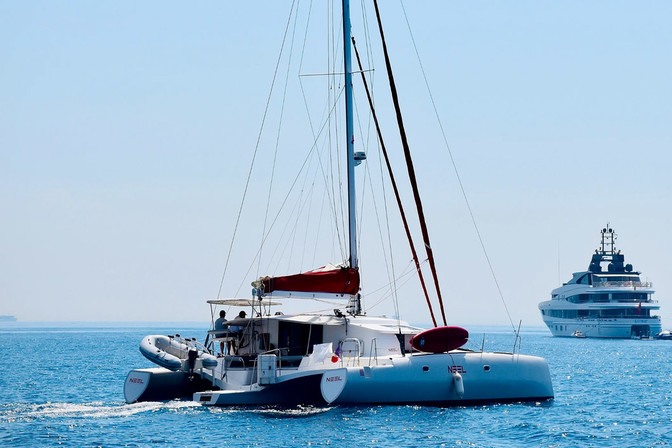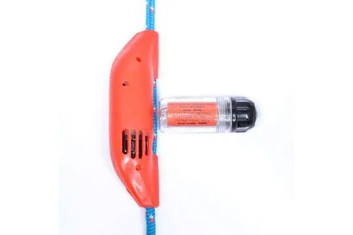
Issue #: 191
Published: September / October 2023
- Price per issue - digital : 6.50€Digital magazine
- Price per issue - print : 9.50€Print magazine
- Access to Multihulls World digital archives Digital archives
End of the season, changing cruising area, transport to a boatyard or new home port, boat delivery by a professional skipper is an unavoidable option for many owners.
Delivering a boat is about more than just sailing, it requires the precision and expertise of a qualified skipper able to move your boat safely over long (or shorter) distances.
Benoît, a professional skipper on the Capt'n Boat platform, shares his logbook from the delivery of a brand-new NEEL 43 trimaran from La Rochelle, in France, to Pula, in Croatia. His report demonstrates the rigor and professionalism required to successfully complete such a mission.

Delivering a boat means moving it from point A to point B by sea. This can be a complex operation, requiring in-depth expertise in navigation, crew management and anticipating weather conditions. The expertise of a skilled skipper like Benoît offers added guarantees in terms of safety and navigation. Furthermore, having your boat delivered saves you precious time. Instead of worrying about logistics and navigation, you can focus on other aspects of your life or business. In Benoît's case, the aim of the delivery mission was to transport the NEEL 43 to Croatia within a set timeframe in order to deliver it to its owner. The challenges were to define the most efficient route according to the weather conditions and to respect the boat so as to deliver it in as-new condition.
Benoît's mission begins by getting acquainted with the boat he will be delivering: a NEEL 43. His keen professional seaman's eye immediately spotted the boat's features: spacious engine room, electrical circuits, clear and organized electric, water, and fuel systems – a captain's dream! "Although the size and volume of the boat may give the impression it has a lot of windage1, the 50hp Volvo Penta engine and bow thruster make maneuvering smooth and easy," explains Benoît after his initial experience with the vessel.
Benoît and his crew then proceeded with the technical preparation of the boat: provisioning, securing equipment, preparing the route and studying the weather."We decided on a departure for the morning of Wednesday March 15 with a good tidal current, calmer wind and sea, which would be more favorable for getting to grips with a new boat than the previous day's conditions, which were a little rough in the Bay of Biscay.”

Departure at 10.00 am bound for Porto de Cariño in Spain. On this first leg, Benoît and his crew covered about 320 nm until the morning of Friday March 17. At the start, the conditions were ideal: winds on the beam of Force 3 to 4 on the Beaufort scale2 allowed the mainsail to be fully hoisted and the genoa to be unfurled. A slight sea state (3 on the Douglas scale3) enabled the crew to reach a speed of 7 knots. Gradually, the wind and sea decreased, forcing Benoît to start the engine: "With 2,000 rpm and what wind remained, we maintained a speed of 6.5 knots." Benoît points out that the engine is often used during a delivery trip, because the aim is to deliver a boat within the allotted time, not to go sightseeing!
1 Windage: this refers to a boat's effect of the wind on the boat itself, influenced by its weight and size.
2 Beaufort scale: a scale for measuring and forecasting wind speed
3 Douglas scale: used to describe the sea state and the swell.
Saturday March 18 at 09:00 Benoît set off for Cascais (around 300 nm) and stopped at the port of Péniche to refuel. This allowed Benoît to calculate an average fuel consumption of less than 0.9 gal (3.4 liters) per hour : this information was crucial for the rest of the journey.
On arrival in Cascais (Portugal), an initial engine check is carried out to ensure the smooth continuation of the journey.
From Tuesday 21st to Thursday 23rd, the crew covered 270 miles reaching Barbate in Spain. Conditions were favorable, allowing Benoît and the first mate to alternate watches of 30 to 40 nm. As they reached Vila Do Bispo, the wind dropped and the engine had to be used: "I noticed that at 1,800 rpm, the little 50 HP engine only consumed 0.8 gal (3 liters) per hour: more useful information."
Arriving in Barbate, Benoit had to wait for the right moment to pass through the Straits of Gibraltar, as he reminded himself: "There are only one rule for passing Gibraltar with a small boat: you only pass with the tidal current and the wind, otherwise you wait". Waiting allowed him to buy a Pinger (photo below), a sound repellent to ward off the pod of orcas currently occupying the strait. A good way of avoiding towing and repairs caused by orca attacks (for more information about orcas attacks, discover our article in MW189, "Should we be afraid of killer whales?").

On Thursday March 23, the conditions were right, and the NEEL 43 crossed the Straits of Gibraltar calmly with a northerly wind of between 3 and 7 knots and the sea on the quarter.
On Wednesday March 29 at 3pm, the crew arrived at San Vito Lo Capo (Sicily, Italy) and carried out three tasks: refueling, provisioning and rest, as well as a meticulous inspection of the boat (hull, bilges, engine, rigging, etc.)
Departure for Vela Luka was scheduled for the following day : around 58 nautical miles to cover. The crossing of the Adriatic was made quickly so that the crew could be as close as possible to the Croatian coast before the start of the forecast Bora episode (a north-easterly wind). As they skirted the island of Korčula, the wind picked up and reached Force 7 to 8, so Benoît decided to take shelter in the marina at Vela Luka to wait for better conditions. That's what being a good skipper is all about: anticipating changes in the weather and making the right decisions for the crew and the boat!
Final stage: Vela Luka - Pula
The final straight! With 180 nm to go, they reached Pula on Wednesday April 5 at 10.00 am. "At the far end of Verdura marina, the gusts were still reaching 25 knots, but with the help of the bow thruster, mooring stern-to went without a hitch. In the company of the owner, we conducted a thorough inspection to review the trimaran. The mission was a success," concludes Benoît.

Call on a professional Capt'n Boat crew to deliver your boat!
What readers think
Post a comment
No comments to show.